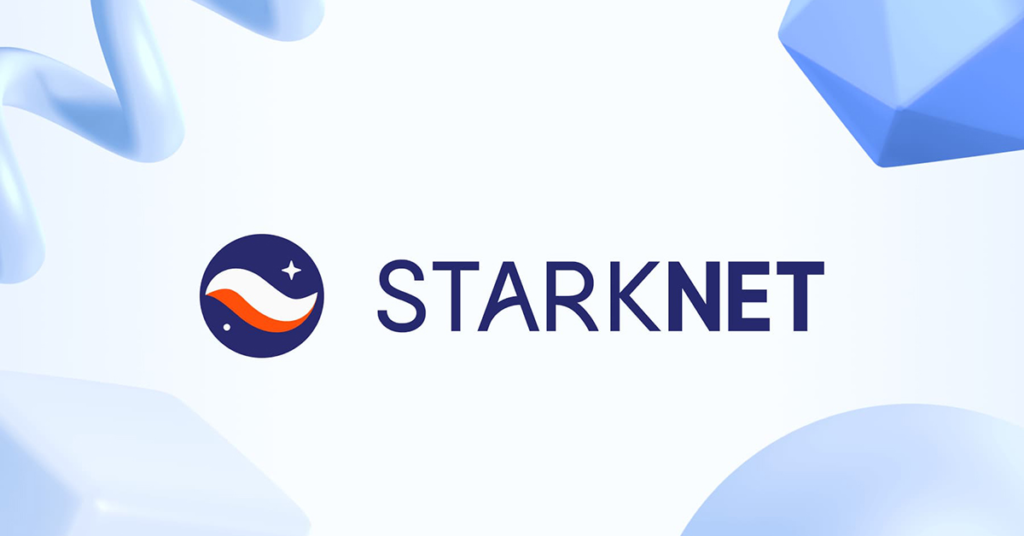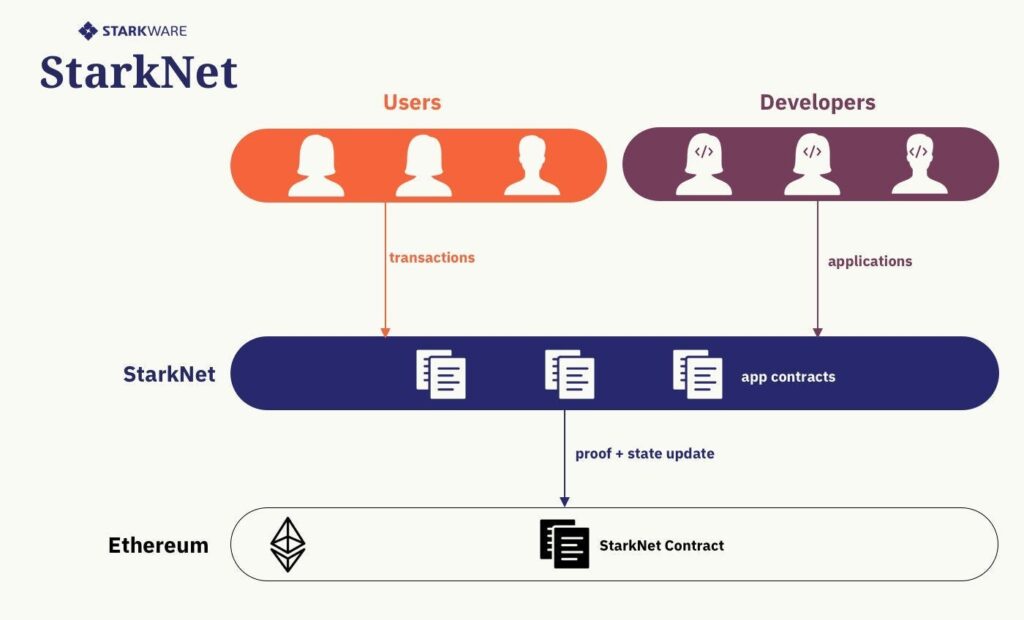Starknet is an Ethereum layer-2 scaling solution that uses a zero-knowledge rollup based on StarkWare Industry’s trustless “STARK” proof.
Starknet is one of many layer-2 scaling solutions (L2s) for Ethereum. There are multiple approaches to increasing transaction speeds and decrease costs, but one of the most popular has become zk-rollups. Both commonly-found types of rollups—the other is called “optimistic”—perform some amount of computation off-chain, so that some work can be done without using the resource-intensive Ethereum mainnet. They then batch many transactions together to document them on the network. This decongests Ethereum while users experience discounted fees.
Previous zk-rollups have used a technology called zk-SNARKS. However, Starknet’s innovation is called the Scalable, Transparent Argument of Knowledge (STARK). A zk-STARK uses two components—sequencers and provers—to mathematically validate transactions, create a STARK proof, and then communicate with smart contracts on Ethereum’s mainnet to formally record transactions. Starknet also uses its own coding language called Cairo, which is intended to make development more accessible to programmers.
Although Starknet initially allowed payment for network fees in the form of Ethereum’s ETH token, it has since added an alternative medium of exchange: a native STRK token. STRK is not only used to pay transaction fees, but is also used for staking and governance purposes—maintaining the network and helping drive its development.

Table of Contents
How was Starknet developed?
Starknet was developed by StarkWare Industries, an Israeli tech company founded in 2018 by Eli Ben-Sasson, Uri Kolodny, Michael Riabzev, and Alessandro Chiesa. Ben-Sasson was also a founder of the privacy-focused Zcash cryptocurrency that was based on Bitcoin. At the time of Starknet’s founding, he was a professor at Technion – Israel Institute of Technology, and in 2019, Technion sued him over intellectual property (IP) allegations. This eventually resulted in a settlement and Ben-Sasson’s departure from the institution.
StarkWare’s first product was StarkEx, a permissioned scaling solution introduced in 2020 that uses the same zk-STARK technology behind Starknet. It is used by decentralized derivatives exchange dYdX and the L2 Immutable X. However, StarkWare ultimately aimed to build its own permissionless L2, and that effort culminated in the publishing of Starknet’s genesis block in November 2021. Exactly one year later, the Starknet token (STRK) was deployed on the Ethereum Mainnet, though the tokens were not immediately offered for sale. They became publicly available in February 2024.
Within its first five years, StarkWare was one of the industry’s most well-funded projects. Its seed funding round from private investors was quickly followed by a $12 million grant from the Ethereum Foundation. It continued to receive hundreds of millions of dollars in funding from notable participants including the now-defunct Alameda Research, Paradigm, Sequoia Capital, and other venture capital firms.
How does Starknet work?
Starknet uses zk-STARKs, or Zero-Knowledge Scalable Transparent Argument of Knowledge. This technology provides a powerful way to verify the integrity of off-chain computations while preserving user privacy.
Because the purpose of blockchain is to make all interactions decentralized and trustless, off-chain processing (found in multiple types of scaling solutions) must be validated in a similarly trustless way. Starknet accomplishes this by using a Scalable, Transparent Argument of Knowledge (STARK) proof, which was first introduced in 2018. Unlike their older cousin, zk-SNARK, zk-STARKs do not require trust in a centralized party during their set-up.
In practical terms, Starknet employs zk-STARKs to produce succinct and transparent proofs of computational integrity. These proofs enable off-chain services to execute various transactions and computations efficiently, without burdening the Ethereum mainnet. Once these computations are completed off-chain, a single zk-STARK proof is generated and posted on-chain to validate the accuracy of the computations. That’s how zk-STARK can ensure the security and integrity of the entire process while not burdening Ethereum.
Starknet boasts a plethora of features designed to enhance its functionality and usability:
● Low Costs: Transactions on Starknet are significantly cheaper compared to Ethereum’s mainnet, thanks to the efficient off-chain processing enabled by zk-STARKs.
● Speed and Efficiency: With upcoming releases focused on optimizing transaction speed and cost-effectiveness, Starknet continues to push the boundaries of what is possible in decentralized transaction processing.
● Developer-Friendly: Starknet provides developers with a user-friendly environment for building dApps using its native language, Cairo. This simplifies the development process and accelerates innovation within the ecosystem.
● Cairo: Cairo serves as Starknet’s native language for creating STARK-based smart contracts, offering a safe and convenient platform for developers to build scalable and secure dApps.
● Account Abstraction: Account abstraction allows smart contracts to handle funds without users needing to give away control of their funds. Starknet implements account abstraction at the protocol level, allowing for diverse signing schemes while ensuring user security and self-custody of assets.
● Volition: This feature empowers developers to regulate data availability on Ethereum (L1) or Starknet (L2), further reducing costs and enhancing efficiency.
● Paymaster: Starknet introduces the concept of a Paymaster, allowing users to choose how to pay for transaction fees and supporting gasless transactions for enhanced accessibility. This helps new users onboard Starknet.

Sequencers and provers
There are two main components of Starknet’s STARK-based L2: the sequencers and the provers.
Transactions are submitted to Starknet just as they would be on the mainnet. These are first processed and validated by sequencers, which act like Ethereum nodes with more capabilities. These computers put transactions into a queue called a mempool, and they propose blocks and then place these transactions into those blocks. Unsuccessful transactions don’t move forward. Once a group of transactions are executed and finalized into a block, the sequencer communicates to other sequencers for approval, and then the block is sent to provers.
Provers are responsible for further guaranteeing transactions in a block are valid. They organize blocks in groups (like sequencers process transactions) and process them in parallel, which makes the process faster. In doing so, they create an Execution Trace and a State Diff, which record the steps of transaction execution and how the state of Starknet changes, respectively. The Execution Trace then is fed through an algorithm that mixes together its data and identifies any bad data (such as a single bad transaction). A small, random sample of transactions is then used as a verification for the STARK proof that contains thousands.
Publishing to the Ethereum mainnet
The STARK proof and State Diff are then communicated back to the mainnet as a single Ethereum transaction. This is how Starknet scales so effectively: it batches thousands of transactions into this one transaction.
On Ethereum, a node accepts the transaction and unpacks it to find the proof and State Diff, which are then processed by the Verifier smart contract. The Verifier examines the samples in the proof to ensure their validity and then passes the next step to the Starknet Core smart contract. At this step, there is confirmation that the proof is valid (per the Verifier) and that the State Diff is present, and the Starknet’s state is updated on Ethereum. The rest of the process is Ethereum’s usual operating procedure: adding the Starknet transaction to a block and then sending it to the network to be validated and finalized.
How is the STRK token used?
The STRK token has three primary uses: 1) payment of fees, 2) governance, and 3) staking.
Like other blockchain-based networks, users of Starknet must pay fees in order to submit and process transactions. The flow of transaction fees helps to provide the economic incentives that drive use of the network. STRK can also be used to participate in community governance of the protocol. This is performed by “wrapping” STRK to turn it into vSTRK (voting STRK) in a 1:1 ratio, which allows a user to vote or designate another user—a delegate—to vote for them. vSTRK can then be unwrapped to STRK to be used for other purposes.
Finally, when the STRK token was first introduced in February 2024, there were plans for using it as part of a future Proof of Stake (PoS) network. However, Starknet had not yet transitioned from a “sequencer + prover” to a PoS protocol, so this use for STRK was still theoretical.
Token supply and distribution
At inception, there were ten billion STRK tokens created by StarkWare. Although this was the total supply at launch, it is not considered the maximum supply. The development team planned for future releases of tokens through the protocol through staking and block rewards, but a process for this was not immediately implemented, in anticipation of guidance via community governance.
Of the original ten billion tokens, 20.04% were allocated to the development team and early contributors, 18.17% to investors, 10.76% to StarkWare, 12.93% to grants to develop the protocol, 10% to the Starknet Foundation’s strategic reserve, 9% each to provisions and rebates, 8.1% to the Starknet Foundation treasury for other purposes, and 2% for donations to institutions and organizations.
Relevant tokens were subject to a lock-up period so parties like the team and investors could not dump their tokens onto the market. However, StarkWare faced early backlash about a particularly short lock-up period of those tokens: 13% of tokens would be unlocked within approximately 2 months of public launch. Because of this, the lock-up schedule was quickly revised.
The STRK token distribution is designed to promote diverse participation and reward a wide range of contributors within the network starknet. Some key aspects of the STRK token distribution include:
- Scope and duration. The distribution will take place from February 20 to June 20, covering nearly 1.3 million eligible wallets, allowing users to claim their tokens over a four-month period.
- Quantity and purpose. More than 700 million STRK tokens, representing 7% of the total supply of 10 billion, will be distributed, highlighting the foundation’s commitment to decentralization and community governance in the ecosystem. starknet.
- Eligibility. Eligibility to claim STRK tokens extends to various segments of the community, including early adopters of starknet, Ethereum contributors and open source developers, who have played integral roles in advancing and testing Stark-based technology.
- Community initiatives. La starknet Foundation has spearheaded several community initiatives to encourage participation and decentralization in the ecosystem, including the “devonomys” program and future efforts such as rebates and subsidies to incentivize ecosystem activity.

Testers and Validators
Within starknet, “testers” and “validators” play crucial roles in transaction processing and verification. Here is the detailed information about these roles:
- Testers (ZK Operators): These are those in charge of preparing zk-STARK tests for transactions in starknet, orchestrating the Merkle tree data structure to create accurate and reliable tests. Its main function is to develop cryptographic proofs that guarantee the accuracy and reliability of transactions, which contributes to the integrity and security of the network.
- Validators: They act as scrutineers of authenticity, confirming the validity of ZK tests, which is essential for the integrity and accuracy of contract execution. They ensure the legitimacy of transactions and the secure execution of contracts, playing a crucial role in the verification and validation of ZK proofs.
Validation Process
The validation process in starknet involves transaction verification and computational testing to ensure the integrity and accuracy of operations within the network. This process is crucial to maintaining the security and reliability of decentralized applications (dApps) running on starknet. Below is an overview of the validation process:
- Sending transactions: Users send transactions to starknet for processing, which may involve various operations within decentralized applications or smart contracts.
- Test generation: Operators, also known as “probers,” generate zero-knowledge proofs (ZK proofs) for transactions. These tests are cryptographic evidence that the calculations performed are valid without revealing sensitive information.
- Test verification: Validators play a key role in the validation process by verifying the authenticity and accuracy of ZK proofs submitted by operators. They ensure that calculations and transactions comply with predefined rules and are valid within the network.
- Consensus and purpose: Once ZK tests are validated, a consensus mechanism within starknet finalizes transactions, ensuring they are added to the blockchain in a secure and tamper-proof manner.
- Execution and settlement: Validated transactions are then executed and the resulting state changes are settled within the network, updating the ledger and relevant smart contracts accordingly.
Cairo and Cairo VM
Another important part in the functioning of StakNet is Cairo and its VM, Cairo VM (CVM). Below is a detailed explanation of Cairo and Cairo VM within starknet:
Cairo
Cairo is a high-level language that has been developed to offer a secure and efficient environment for the creation of smart contracts in starknet. Its main features include:
- Security and verification. Cairo is designed with a focus on security and verification. Its design focuses on reducing the possibility of errors and vulnerabilities in smart contracts.
- Efficiency. Cairo is optimized for efficient execution on the Cairo VM, meaning that contracts written in Cairo can be executed efficiently, reducing gas costs and improving performance.
- Ease of use. Although it is a powerful language, Cairo is designed to be accessible, with clear syntax and development tools that make it easy to create and maintain smart contracts.
Cairo VM
For its part, Cairo VM is the virtual machine that runs smart contracts written in Cairo. Some important aspects of the Cairo VM are:
- Efficient execution. Cairo VM is optimized for efficient execution of contracts written in Cairo, contributing to the scalability and efficiency of starknet.
- Security. Like the Cairo language, the Cairo VM focuses on the security and integrity of smart contract execution, which is critical for the reliability of decentralized applications in starknet.
- Interoperability. Cairo VM is designed to be interoperable with the Ethereum network, enabling the execution of smart contracts on a Layer2 with the security and reliability of the mainnet.
In summary, Cairo and Cairo VM are crucial components of starknet, providing a secure, efficient and scalable environment for the creation and execution of smart contracts on the Ethereum network.
How is Starknet (STRK) Stored?
STRK operates on the Starknet blockchain. You can manage STRK balances using browser, desktop, mobile, and hardware wallets that support Starknet blockchain.
How to Buy and Sell Starknet (STRK)?
To buy and sell Starknet (STRK) using Turkish Lira and Tether, you can use the BtcTurk | Kripto website or the BtcTurk | Kripto mobile application. If you are not a member of BtcTurk | Kripto, you can sign up immediately on our website or mobile app. You can buy STRK (STRK) by depositing Turkish Lira, this can be done 24/7 if using one of our seven affiliated banks.
Conclusion
- Starknet is an Ethereum layer 2 scaling solution that uses a zk-rollup to transfer processing of transactions off-chain in an effort to increase their speeds and decrease their cost.
- The zk-STARK mechanism involves sequencers and provers who are responsible for ensuring off-chain computation is verifiably accurate, and “bad’ data does not reach the Ethereum mainnet.
- The STRK token facilitates transactions by providing a means for paying fees on the network, and it can also be used in governance and in staking.
Disclaimer ||
The Information provided on this website article does not constitute investment advice ,financial advice,trading advice,or any other sort of advice and you should not treat any of the website’s content as such.
Always do your own research! DYOR NFA
Coin Data Cap does not recommend that any cryptocurrency should be bought, sold or held by you, Do Conduct your own due diligence and consult your financial adviser before making any investment decisions!





Leave feedback about this